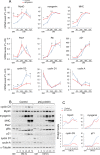Cyclin D3 critically regulates the balance between self-renewal and differentiation in skeletal muscle stem cells
- PMID: 23897741
- PMCID: PMC3963451
- DOI: 10.1002/stem.1487
Cyclin D3 critically regulates the balance between self-renewal and differentiation in skeletal muscle stem cells
Abstract
Satellite cells are mitotically quiescent myogenic stem cells resident beneath the basal lamina surrounding adult muscle myofibers. In response to injury, multiple extrinsic signals drive the entry of satellite cells into the cell cycle and then to proliferation, differentiation, and self-renewal of their downstream progeny. Because satellite cells must endure for a lifetime, their cell cycle activity must be carefully controlled to coordinate proliferative expansion and self-renewal with the onset of the differentiation program. In this study, we find that cyclin D3, a member of the family of mitogen-activated D-type cyclins, is critically required for proper developmental progression of myogenic progenitors. Using a cyclin D3-knockout mouse we determined that cyclin D3 deficiency leads to reduced myofiber size and impaired establishment of the satellite cell population within the adult muscle. Cyclin D3-null myogenic progenitors, studied ex vivo on isolated myofibers and in vitro, displayed impaired cell cycle progression, increased differentiation potential, and reduced self-renewal capability. Similarly, silencing of cyclin D3 in C2 myoblasts caused anticipated exit from the cell cycle and precocious onset of terminal differentiation. After induced muscle damage, cyclin D3-null myogenic progenitors exhibited proliferation deficits, a precocious ability to form newly generated myofibers and a reduced capability to repopulate the satellite cell niche at later stages of the regeneration process. These results indicate that cyclin D3 plays a cell-autonomous and nonredundant function in regulating the dynamic balance between proliferation, differentiation, and self-renewal that normally establishes an appropriate pool size of adult satellite cells.
Keywords: Cell cycle; Muscle stem cell; Myogenesis; Regeneration; Satellite cell; Self-renewal.
Copyright © 2013 AlphaMed Press.
Figures







Similar articles
-
Stem cell function, self-renewal, and behavioral heterogeneity of cells from the adult muscle satellite cell niche.Cell. 2005 Jul 29;122(2):289-301. doi: 10.1016/j.cell.2005.05.010. Cell. 2005. PMID: 16051152
-
CCAAT/enhancer binding protein β is required for satellite cell self-renewal.Skelet Muscle. 2016 Dec 7;6(1):40. doi: 10.1186/s13395-016-0112-8. Skelet Muscle. 2016. PMID: 27923399 Free PMC article.
-
Satellite Cell Self-Renewal.Curr Top Dev Biol. 2018;126:177-203. doi: 10.1016/bs.ctdb.2017.08.001. Epub 2017 Oct 23. Curr Top Dev Biol. 2018. PMID: 29304998 Review.
-
Zfp423 Regulates Skeletal Muscle Regeneration and Proliferation.Mol Cell Biol. 2019 Apr 2;39(8):e00447-18. doi: 10.1128/MCB.00447-18. Print 2019 Apr 15. Mol Cell Biol. 2019. PMID: 30692273 Free PMC article.
-
Stem cells in postnatal myogenesis: molecular mechanisms of satellite cell quiescence, activation and replenishment.Trends Cell Biol. 2005 Dec;15(12):666-73. doi: 10.1016/j.tcb.2005.10.007. Epub 2005 Oct 21. Trends Cell Biol. 2005. PMID: 16243526 Review.
Cited by
-
Dietary protein levels changed the hardness of muscle by acting on muscle fiber growth and the metabolism of collagen in sub-adult grass carp (Ctenopharyngodon idella).J Anim Sci Biotechnol. 2022 Aug 25;13(1):109. doi: 10.1186/s40104-022-00747-7. J Anim Sci Biotechnol. 2022. PMID: 36002862 Free PMC article.
-
Metabolic Reprogramming Promotes Myogenesis During Aging.Front Physiol. 2019 Jul 10;10:897. doi: 10.3389/fphys.2019.00897. eCollection 2019. Front Physiol. 2019. PMID: 31354530 Free PMC article.
-
Fluorescence microscopy data on expression of Paired Box Transcription Factor 7 in skeletal muscle of APOBEC2 knockout mice.Data Brief. 2018 Feb 27;17:1348-1351. doi: 10.1016/j.dib.2018.02.063. eCollection 2018 Apr. Data Brief. 2018. PMID: 29876490 Free PMC article.
-
Molecular pathways involved in the control of contractile and metabolic properties of skeletal muscle fibers as potential therapeutic targets for Duchenne muscular dystrophy.Front Physiol. 2024 Dec 9;15:1496870. doi: 10.3389/fphys.2024.1496870. eCollection 2024. Front Physiol. 2024. PMID: 39717824 Free PMC article. Review.
-
Nuclear Phospholipids and Signaling: An Update of the Story.Cells. 2024 Apr 19;13(8):713. doi: 10.3390/cells13080713. Cells. 2024. PMID: 38667329 Free PMC article. Review.
References
-
- Collins CA, Olsen I, Zammit PS, et al. Stem cell function, self-renewal, and behavioral heterogeneity of cells from the adult muscle satellite cell niche. Cell. 2005;122:289–301. - PubMed
-
- Zammit PS. All muscle satellite cells are equal, but are some more equal than others? J Cell Sci. 2008;121(Pt 18):2975–2982. - PubMed
-
- Kuang S, Gillespie MA, Rudnicki MA. Niche regulation of muscle satellite cell self-renewal and differentiation. Cell Stem Cell. 2008;2:22–31. - PubMed
-
- Wang YX, Rudnicki MA. Satellite cells, the engines of muscle repair. Nat Rev Mol Cell Biol. 2012;13:127–133. - PubMed
Publication types
MeSH terms
Substances
Grants and funding
LinkOut - more resources
Full Text Sources
Other Literature Sources
Medical
Miscellaneous

